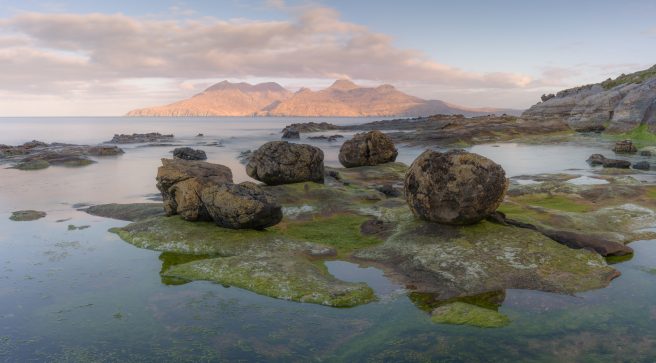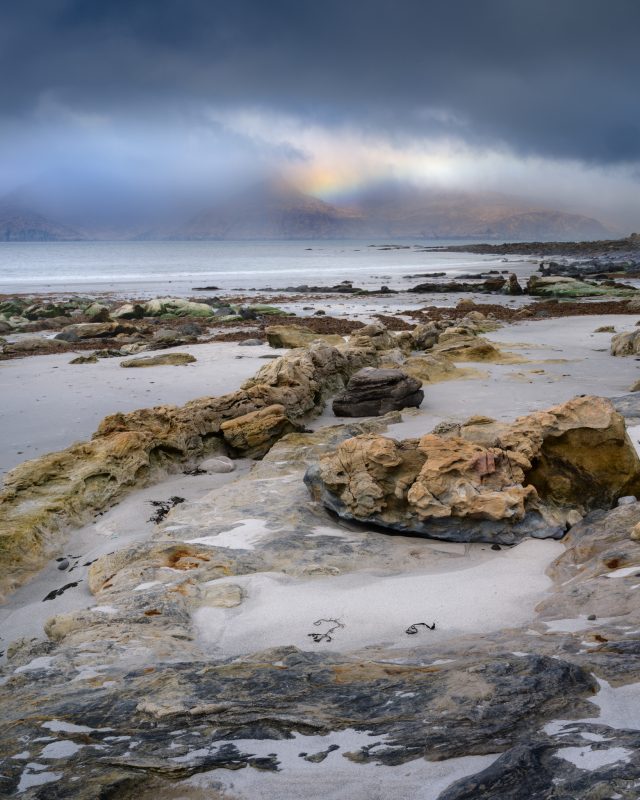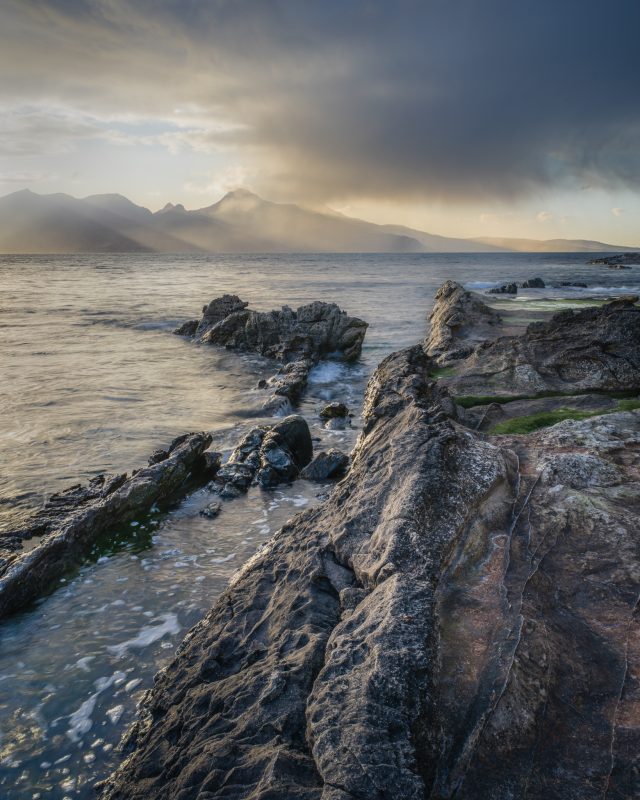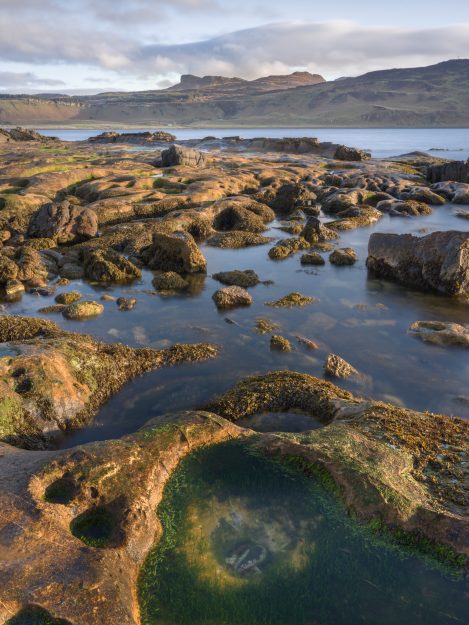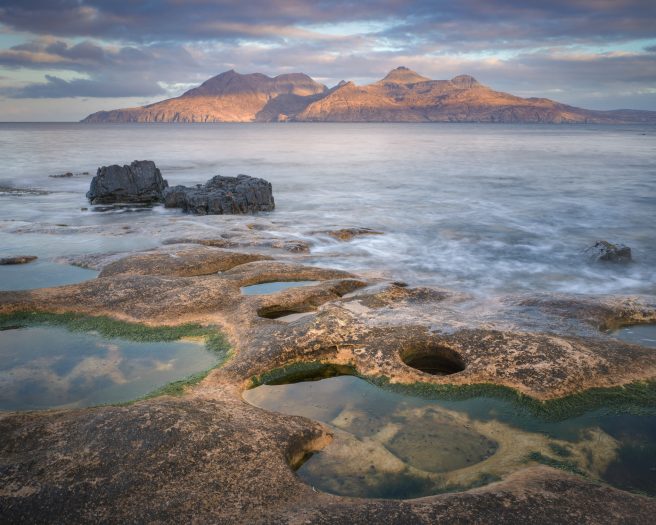Hasselblad CFV100C
The balance between portability, quality and function has always been difficult when working away from motorised transport. Typically, I have reached for the 35mm based mirrorless system when portability was the most important aspect; but the introduction of the latest Hasselblad CFV 100C / 907X and the newer ‘V’ and ‘P’ lenses enables a way to go small without compromise. This short article comes from a week long trip to the island of Eigg in Scotland where walking is the only mode of transport for visitors, and the CFV 100C / 907X combination came into its own.
Over the years, most of my landscape work has been done with 5x4 cameras and sheet film. The migration to digital became affordably compelling with the introduction of the Sony A7R, and since then, I have pottered about with most of the genres as the manufacturers leapfrogged with new technology. There was (and still is) something fascinating about the larger formats and the ability to use technical cameras for considered landscape work. I retain a technical camera system with a range of lenses for use only with a digital back (DB). This was my expectation and primary intended use for the CFV 100C. Not the most portable though… which brings me back to Eigg.
The CFV 100C has a unique solution when hitched to the included 907X camera body. The combination of this, the CFV 100C and the newer tiny (ish) ‘V’ and ‘P’ lenses makes for a very compact and incredibly portable system. For those with long memories, it is similar in size and form to the legendary Hasselblad SWC (super wide) camera. Added benefits come in the ability to downscale all the peripheral gear you need like the tripod, the head, the bag and if necessary, the filter system.
Comfort in the field has a huge impact on how I approach taking pictures and has a direct consequence on the quality of the images I produce. Having been to Eigg before, I knew that I would not need any long lenses, so travelled with the 28mm P, the 38mm V and the 65mm (which I never used), leaving the technical camera and 90mm lens at home
About Eigg
Eigg is interesting on so many levels with a unique island atmosphere. The geology is fascinating, with remarkable Jurassic strata and a violent volcanic past, which is laid bare in the landscape. The most obvious feature is the distinctive Sgurr, which is pitchstone from lava flows, and not a volcanic plug as most assume. There are obvious volcanic features all over the Island with dykes crisscrossing the beaches and cliffs and great terraces of basalt. All the while, you can see and feel the menace of the ancient volcanoes responsible for the incredible forces that tore this land apart and formed Skye and Rum, which is ever present to the west.
The CFV 100C & 907X
The combination of CFV100C and 907X makes a very basic box camera. It is easier to write a list of things it doesn’t do, rather than what it has as a feature set. But it has some important technical components.
The sensor is Back Side Illuminated (BSI), which means that it is quite close to gapless in design, so the issues of colour casts suffered by the previous generation have largely been removed. This applies mostly when using it as a digital back for a technical camera. But other wide angle lenses, where the rear element is very close to the sensor, could give a magenta cast in the corners with the previous model. Hasselblad’s latest 28mm is an example of a lens that exhibited purple corner shading issues with the earlier 50mp series camera. Previously, a Lens Cast Calibration filter was required with any Schneider or Rodenstock lenses of 50mm focal length or wider.
The diminutive 907X camera body gives auto-focusing, and has good face detection taking advantage of Phase Detect Auto Focus (PDAF) on the sensor. This does make the AF quick and reliable. But it can introduce a problem that Hasselblad are yet to effectively solve, whereby the PDAF array can provoke lines that appear with some wide-angle lenses. This is particularly true with the more symmetric optics like the Schneider 47/35mm lenses, and to a lesser extent with the slightly telecentric designed Rodenstock 40mm and wider lenses. The PDAF array is slightly raised from the sensor and the ‘shadow’ causes the lines. It is not unique to Hasselblad, and most manufacturers had this issue when first moving to the BSI sensor. They have addressed the problem through firmware. In practical use, I have not been bothered by it, as it requires extremes of post processing to be noticeable, and then only on large areas of plain tone or colour (like blue sky).
The 907X is shutterless, so either a lens has to have a shutter (nearly all Hasselblad lenses have one) that can be triggered by the camera or you may rely on the Electronic Shutter to take pictures. One of the difficulties of 100 megapixels is the amount of data that has to be moved off the chip at the time of exposure. Apart from the latest Global shutters, which read data in one go, current chips read off data line by line. If using the electronic shutter then the amount of time to read the whole chip can mean that the movement of any object may be distorted (rolling shutter). The Electronic Shutter in the CFV 100C has a fast enough readout that this is rarely an issue in landscape use, especially in 14 bit rather than 16bit mode where the readout is quite a bit slower. This is an essential feature allowing the use of shutterless lenses with the back, for example, when using a technical camera.
For storage, a 1TB SSD is built into the back with a secondary back up CFexpress type B slot, and this completes the important technical components.
On top of the tech is a very simple User Interface easily managed via a good-sized responsive touch screen which works well. The screen is good enough even in bright light, and hinges upwards so the screen acts as a waist level finder, as per the Hasselblad 500 series film cameras.
What doesn’t it have?
Well, this may sound negative, but in reality, the features it has are designed for the purpose intended, nothing more, nothing less. If you want/need things on this following list then it is the wrong camera for you.
IBIS: (lack of)
In many ways the biggest drawback. Hasselblad lenses do not have OIS either, so with 100mp of detail my keeper rate, handheld, dropped alarmingly with the CFV 100C + 907x combination. I am quite comfortable handholding with IBIS and wide/normal lenses at 1/10th of a second, expecting a reasonable hit rate on the Hasselblad X2D, or Fujifilm GFX 100S (previously owned). With the 907X I find a shutter speed that is 1/focal length, as per the old maxim, is a fair low limit for handholding.
AF-C/AF Tracking: (lack of)
You aren’t going to use this camera for moving subjects.
Joystick: (lack of)
This has become standard on the majority of higher end cameras (but the X2D doesn’t have one either). It can be added to the 907x with the optional grip, but then the stability on a tripod is compromised due to a very thin connection to the plate. The touchscreen is excellent and easy to use so for tripod use this not an issue except perhaps in climatic conditions where your fingers do not operate the ‘touch’.
Screen angle
This may feel quite minor, but what does somewhat affect useability in the field is the screen angle: The design of the back is close to the original film magazine of the 500 series cameras. It is beautiful but… the screen slopes, and hinges in one direction only. This is perfectly fine if you only shoot in landscape format, or use it on a 500 series or shoot square format. As soon as you shoot portrait then it becomes quite disorienting. I am not the only one to find it much harder to compose because the angle of the screen leaves you looking in a different direction to the one you expect. A fully articulating screen could solve this.
Tripod solutions
Before going into the field, the biggest problem to solve has been effective and secure coupling of a tripod plate. The 907X is very thin, and although it does have an indent to prevent rotation of the plate there are a very limited number that have the pin in the right place. Arca Swiss have a plate that is for “Classic Leica R” that is secure but ergonomically poor, not matching the camera profile. The best solution is the MC-LS Universal ‘L’ bracket from Really Right Stuff. Elegant and neat, it could have been made for the camera, and it also fits the X2D perfectly.
Lens Choices
Hasselblad is gradually migrating away from the older style XCD lenses with the newer ‘P’ (Pancake) , ‘V’ (Versatile) and ‘E’ (Exclusive) series. My experience with the new and old lenses is that there is not a bad lens in the bunch, and choice can be made based on the focal length you need. Zoom lenses are limited to older series 35-75mm and newer 20-35mm E series. Long lenses are limited to 120mm Macro and 135mm with matched 1.7x converter. I am comfortable using these lenses stopped down to f/22 as needed for Depth Of Field, despite conventional wisdom suggesting that images should be severely degraded by diffraction.
Personally, I own 25, 38, 55 and 90mm ‘V’ lenses, have owned the 28mm ‘P’, which I replaced with the 25mm; and have tested the 35-75mm XCD.
My most used lens is the 38mm. It is a compact high-quality package. There is a little bit of field curvature to watch out for when focusing, and a tendency to flare a little more than other lenses I have used.
A selection from the more compact 28P/38/45P/55/75P best complement the size and form of the 907x. The 25mm and 90mm V lenses produced some of the finest images I have made, but they are quite large, especially the 25mm vs the 28mm. The 25mm has proved its worth for Aurora work.
Adapted lenses from 6x4.5/6x6/6x7 film era cameras generally work well, but are not compact. Most are now quite aged, and finding a good copy of a well-regarded lens can be challenging.
Image Quality & Development
I am including these together because there is a lot of debate about how to get the best from the Hasselblad Natural Colour System (HNCS). Like Phase One and its relationship with Capture One it is designed to produce best results from the (in house) remarkably similar-looking Phocus software. You cannot use Capture One with Hasselblad files.
Personally, I have been a Lightroom user for years and am comfortable that I get good results from it. I have done my own comparisons and the power of the additional features in LR far outweigh the small quality or colour differences I thought I could see. The only footnote to that is that LR ‘Camera Standard’ profile is rated as the closest in colour presentation to Phocus. I also use extensively the Tony Kuyper Linear profiles for the Hasselblad cameras with good effect. For images I cannot get quite right in Lightroom I will go to Phocus for initial development before exporting to a .tiff for polishing and cataloguing in Lightroom.
Auto White Balance is uncannily accurate in my opinion, and I almost never have to modify it except to taste. The colours are natural, and greens well handled.
The files from the Hasselblad 100mp sensor and developed in Lightroom are the ‘best’ to my taste from any camera system I have used.
Summary
I have been using the digital backs in both 50 and 100 variants for an extended period. The 907X remains probably my favourite landscape tool if I am not chasing the light; the simplicity and balance works well for me. It needs to be used on a tripod. The small jewel like lenses are a joy to use, especially the ‘v’ variants with the clutch to manual focus.
After several trips where I tried to double duty the 907X as a handheld camera I felt the keeper rate was too low and I complemented it with an X2D. Same wonderful quality, but hand-holdable due to the excellent IBIS.
- Background – Journey to the CFV 100C
- Dyke swarm punched through Jurassic Sandstone on Laig Beach. 28mm P 1.4sec @ F16
- Bay of Laig. Stitch with 38mm. 8sec @ F16
- A dyke pie crust on Singing Sands 38mm 1/8th sec @ F16
- Bay of Laig – 38mm 4sec @ F22
- Storm over Rum. 38mm 0.3sec @ F16
- The Sgurr across Bay of Laig. 38mm 0.3sec @ F16
- Rum at Sunrise. 38mm 1.4sec @ F16
- Rum from Singing Sands at Dawn. 38mm 3sec @ F16
- Micro Plastic debris Singing Sands. 55mm 1/90th @ F11
- Micro Plastic debris Singing Sands. 55mm 1/90th @ F11




